Home
A comprehensive resource for safe and responsible laser use
Laser Glare Protection eyewear for pilots
Below is general information about selecting and using LGPs, as well as a list of LGP eyewear manufacturers we’re aware of.
General information about Laser Glare Protection
-
Pilot Laser Glare Protection vs. conventional Laser Eye Protection
- Laser Glare Protection (LGP) is primarily intended for pilots, to mitigate bright laser light. It has a different goal than conventional Laser Eye Protection (LEP) which has been used for decades in laser labs, industry, laser medicine and the military.
- The goal of Laser GLARE Protection is to reduce laser light brightness to a comfortable or manageable level. Usually it is not desired to block all of the laser light, since a pilot may need to see a laser source in order to report its location.
- The goal of Laser EYE Protection is to reduce or block laser light to a level that will not injure the eye. The laser light may still be very bright, or it may completely disappear.
Both LGP and LEP use the same materials and techniques. The difference is in the amount of light reduction, or Optical Density, which is desired to protect against the selected laser wavelengths (colors).
In almost all cases, Laser Glare Protection also happens to reduce laser light to a level that will not injure the eye. (The only exceptions might be for deep blue or dark red light that inherently does not appear bright to the eye even without LGP or LEP, but that could be above the Maximum Permissible Exposure. Consultation with a LGP manufacturer can determine whether this is even a problem, and if so, how best to address it.) -
How Laser Glare Protection eyewear works
- The photo-illustrations below give an idea of how LGP glasses work:
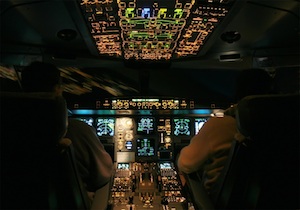
Actual photo of Airbus A330 banking while coming in to land at Zurich airport.
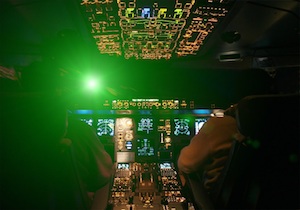
Simulated laser illumination added. Glare prevents view of background lights.
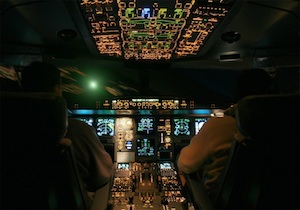
Simulated use of Laser Glare Protection glasses. The laser location is still visible, but glare is significantly reduced. Note that green cockpit lights are not adversely affected -- they can still be seen.
There are three main technologies used to make LEP and LGP eyewear:- Dyes: The plastic used for lenses has a light-absorbing dye built in. Different dyes will absorb different wavelengths.
- Thin-film: Materials are evaporated in a vacuum chamber and are carefully deposited on the lenses, with precise thicknesses. By varying the materials and thicknesses, layers build up that can reflect desired wavelengths of light.
- Holographic: A holographic technique is used to create very thin layers in a material which is then laminated onto the lens surface. Similar to thin-film, these layers are designed to reflect desired wavelengths of light. (This technology is relatively new as of 2019; thus far only one company is producing holographic laser-protection eyewear.)
Each technology has advantages and disadvantages:- Visible light transmission: For dye, the higher the Optical Density to absorb laser light, the lower the overall visible light transmission. For thin-film, increasing Optical Density has less of an effect on visible light transmission. For holographic, in general, increasing Optical Density does not adversely affect visible light transmission.
- Attenuation: Dyes attenuate a relatively wide spectrum, meaning that they absorb not only the desired wavelength of light, but about 25 nanometers on either side of that spectrum. For thin-film the attenuation on either side is about 15-20 nm. The holographic technology has a relatively narrow spectrum of about 8 to 13 nm on either side.
- Angle sensitivity: Dye lenses will absorb the same amount of laser light (or a little more), if the light comes in from an angle versus from the front. For thin-film and holographic lenses, they are most effective with light coming in from the front. Coverage is good for light from about 30 degrees to either side of front (perpendicular to the lens).
- Durability: Because the dye is uniform throughout the lens material, a scratch does not adversely effect the ability to absorb laser light. For thin-film and holographic, the coating or film can be scratched which reduces the ability to reflect laser light; this can be partially alleviated with additional protection layers and coatings.
-
How to select and evaluate Laser Glare Protection eyewear
- The U.S. Federal Aviation Administration is aware of LGPs but currently does not recommend or require LGP use. Pilots who want to use LGP can do so -- subject of course to any rules applied by their airline or employer. Here are some tips:
- Determine the wavelength(s) to be blocked. Green is the primary color listed in FAA laser illumination reports. As of 2019, 532 nm green is the most common. It may be desired to protect against other wavelengths such as 445 nm blue or (as it becomes more available) 520 nm green. Each added wavelength can have an adverse impact on visible transmission and on color discrimination, so the number and type of wavelengths should be carefully considered.
- Determine the Optical Density. Pilots at greater risk – those closer to laser sources, who spend more time looking at or searching after the laser source – should choose a higher OD such as 2. Pilots who rarely encounter laser sources and/or those who are in fixed wing aircraft where the time of exposure is generally brief, should consider a lower OD such as 1.
- Shape, type, coverage, form factor. For LGP eyewear, “aviator” style glasses should be sufficient for most uses. Pilots wearing prescription glasses need to select LGP eyewear which fits over their glasses. Pilots at greater risk who are not bothered by goggle style eyewear may wish to consider this option for additional protection from light coming from the side and bottom (e.g., in a helicopter bubble). If helmets are worn, the LGP eyewear needs to be compatible.
- Compatibility with cockpit displays, caution and warning lights, and airport lighting. It is imperative that users first test the LGP in a safe aviation environment, under low-light conditions such as dusk or dawn as well as on a dark night. Testing under low-light conditions will help ensure that instrument lights will not be washed out by ambient light plus the visible light reduction of the LGP. Testing at night helps ensure that there is sufficient visual light transmission of the LGP even under very dark conditions. Pilots should experience and understand the effect the LGP will have on the airport lights, cockpit displays, caution and warning lights, and general visibility. This should occur on the ground, and in the air during non-critical flight phases. For two-pilot aircraft during flight familiarization, it is recommended that one pilot fly normally (without LGP) while the other pilot familiarizes himself or herself with the LGP’s usage and effects.
- Familiarization and readiness for use. All of the above steps may be meticulously followed, but the LGP is useless if it is not available and ready for quick use if a laser is seen or reported to be in the area. Pilots with LGP need to put them in a readily accessible location every time they will be flying at night. They should practice donning the LGP, in a safe situation during non-critical phases of flight. As with any piece of safety equipment, if it is not readily available then there is no safety.
-
Only consider aviation-specific eyewear
- Pilots should NOT rely on ordinary sunglasses or common “blue blocker” type glasses. Using sunglasses at dusk, night and dawn (when almost all laser incidents occur) could be unsafe. Blue blocker glasses have an effect on many different colors of blue and green. This may adversely effect how cockpit instruments and airport lights are perceived.
Pilots should also be cautious of Laser Eye Protection eyewear (“laser safety glasses”) made for laboratory use, which are not specified for aviation use. They may limit too wide a range of colors, or may not be effective against the most common laser pointer colors. Look for Laser Glare Protection eyewear intended for pilots.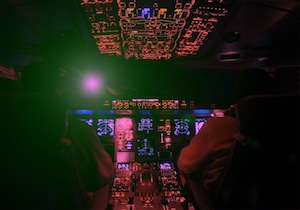
Simulated use of general-purpose green-blocking glasses,
where 50% of broadband green light is blocked.
Note significant change in instrument panel colors.
Obviously, these should not be used for anti-laser purposes. -
When to wear Laser Glare Protection eyewear
- Laser Glare Protection eyewear should be immediately accessible to a pilot, due to laser illuminations being unexpected and usually brief events. However, LGP should not be routinely worn.
- LGP should be donned if a laser illumination happens during or prior to a critical phase of flight.
- It can also be donned if there is a reasonable expectation of a recent, active or possible laser illumination during or prior to a critical phase of flight. For example: news reports of incidents at a specific airport, reports from other aircraft in the vicinity, or notification by air traffic control.
For pilots in a 2-seat cockpit, there may be times where it is advantageous for one pilot to wear LGP and one pilot to fly without LGP. This decision would be best made by the organization using aircraft in an laser environment, and would be highly situation-dependent.
For other crew in the cockpit or on the aircraft, such as the Tactical Flight Officer for a police department helicopter, the use of LGP would be situation–dependent. -
Laser Glare Protection is helpful, but is not a complete solution
- Laser Glare Protection eyewear is helpful, but LGPs are not a complete solution to the laser pointer problem. Some key reasons are:
- Anti-laser glasses can only protect against one or a few specific wavelengths of laser light. Glasses that protect only against a certain green, such as 535 nanometer green, may not be effective against 520 nm green or other colors such as red or the increasingly-common blue lasers.
- Anti-laser glasses will reduce visible light transmittance, so the view may be dimmer.
- In general, the more wavelengths (colors) that are protected against, the dimmer the view — compared with single-wavelength blocking glasses.
- Any laser incident may be over before glasses can be put on. (Or, if the pilot wears them all the time, this means that the glasses are unneeded well over 99.99% of the time.)
But appropriate LGPs, specifically designed for aviation use, can be helpful for pilots who might want to have an extra level of protection against common laser pointers. Any LGP should be safely tested on the ground or during cruise autopilot flight to ensure that the particular indicators and displays in the cockpit are still adequately visible when wearing the glasses.
It is then up to the pilot to decide whether to use these routinely, to use them only at certain airports, or to simply have them available in the cockpit in case laser incidents are reported by other pilots or ATC during a flight.
Additional information about LGPs is in this FAQ question. -
An alternative to eyewear: Windscreen protection
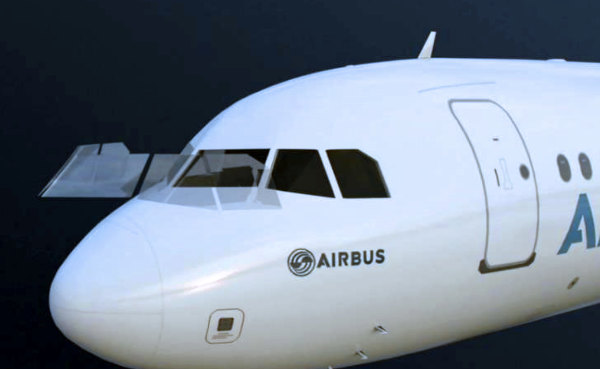 Another technology that is often suggested is putting Laser Glare Protection on the inside of aircraft windscreens.
Another technology that is often suggested is putting Laser Glare Protection on the inside of aircraft windscreens.
Pilots would not need to wear LGP glasses. And, there would be no concerns about the glasses possibly changing the visibility of cockpit screens and lights.
In February 2017, Airbus announced plans to validate, certify and commercialize an anti-laser film applied to the windscreen. This can be put on new aircraft and can also be retrofitted to existing aircraft of any type — not just Airbus.
We have a separate page about windscreen protection for pilots.-
LGP resources and news
- A May 4 news release describes how the Air Force developed anti-laser eyewear for military pilots, and has tested a commercial version: Commercial Aviation Low Intensity or CALI. It is specifically designed so pilots can accurately read the control panel and still have anti-laser protection. One pilot described the effect: "“It doesn’t distort colors too tremendously bad…. I think the biggest distortion that we see is that it does darken up white, making it look more yellowish. But your reds and blues — even your greens — that are displayed on the instrument panel screen still look red, blue and green.” (The story is also reprinted here at LaserPointerSafety.com.)
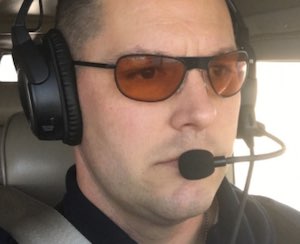
The Commercial Aviation Low Intensity (CALI) laser glare protection glasses developed by the Air Force
June 2018 guidance from an aviation advisory committee, SAE Aerospace Recommended Practice 6378, discusses Laser Glare Protection. An appendix lists LGP products known to the SAE G10-OL committee at time of writing the document.
“Eyewear Helps Thwart Laser-Pointer Attacks”, by Jason Palidwar, Iridian Spectral Technologies. Reprinted from Photonics Spectra, January 2014.
The Air Force Aircrew Laser Eye Protection (ALEP) program. This unclassified document describes many of the characteristics of anti-laser glasses used by the Air Force. It does not list specific wavelengths or protection factors (e.g., optical density) as these are classified. From the abstract: “ It describes design criteria used in the development of laser protective devices, operational considerations, training, fit, inspection, maintenance and immediate response procedures to follow after suspected laser exposure. Procedures outlined in this document apply to all Air Force personnel….” Block 0, 0+ and 1 versions are discussed.
ALEP Program Status: Below is the bottom half of slide 4, in an Air Force briefing about Aircrew Performance Programs. This has more information about ALEP Block 2.Teledyne wins $7.7 million contract for 3,137 ALEP Block 2 spectacles. News item from February 3, 2012.
List of Laser Glare Protection eyewear
Note that most or all of these companies may also have eyewear specifically intended to protect ground officers during protests.
The section "LGP resources and news" above describes LGP eyewear called "CALI" developed by the Air Force for commercial purposes, which is still being tested as of May 2021.
GlareShields from NoIR

As of July 2011, there are three models. PBG reduces green by 99.5%, blue by 97%, has 49% transmittance for low-light conditions, and has “good” instrument panel visibility. AG2 reduces green by 99%, has 53% transmittance for low-light conditions, and has “excellent” instrument panel visibility. BGR is for full sun conditions; it reduces green, blue and red by 90-97%, with 29% transmittance for full sun conditions.
Laser Armor Aviator Glasses from Night Flight
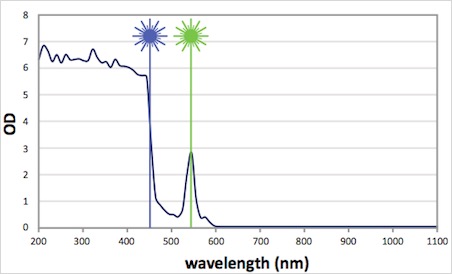
This chart from Night Flight shows Laser Armor Aviator Glasses
absorbing 99.5% of green beams and 97.0% of blue beams
metaAIR eyewear from Metamaterial Technologies Inc.
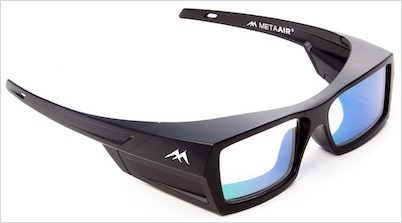
The eyewear is said to have an Optical Density between 2 and 5, meaning that it will attenuate the amount of 532nm light reaching eyes by 100 to 100,000 times. The frame is wider at top, sides and bottom, to block light coming from directions other than the front.
MTI originally developed the holographic laser-reflecting technology for use in windscreens. The goal was to protect pilots without the need for eyewear. However, windscreen modifications require a slow, multi-year process of obtaining governmental and airline approval. In addition, the cost to modify windscreens is much higher than the cost of one or two pairs of eyewear. So eyewear was a natural choice for the first commercially available laser protection product from MTI. According to its metaAIR website, the company may also produce glare shields using the same technology.
As of late February 2019, MTI is taking pre-orders for its eyewear, distributed by Satair, which will be available "spring 2019."
LaseReflect Aviator from Iridian Spectral Technologies
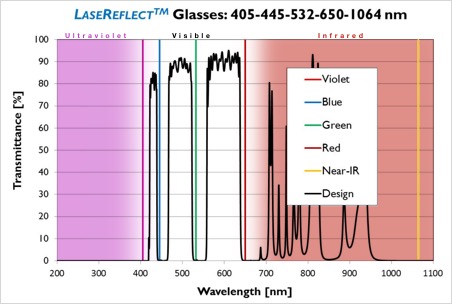
LaseReflect Aviator glasses reflect up to four wavelengths,
with high visibility between these wavelengths
Flash Fighters from Kentek
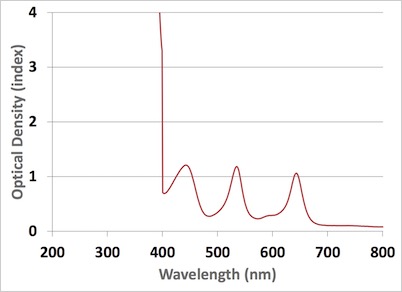
Laser-Gard from Sperian
These glasses have been tested by pilots for a major U.S. airline, who confirm that they can still safely distinguish colors in the cockpit (including green on indicators and LCD displays), and on airport lighting. Informal testing by LaserPointerSafety.com shows that Laser-Gard turns green laser pointer “hits” from being uncomfortably bright, to being minor and manageable. Because 1% of laser light is transmitted, it is still possible to tell where the laser is coming from. This aids in identifying perpetrators.

Sperian has four models of Laser-Gard; two for daylight use (bronze-colored sunglasses that also have laser protection), and two for nighttime use (salmon-colored glasses with maximum light transmission except for the laser wavelength). Within each group, there is green-only protection, and green-and-red protection. The cost for the nighttime, green-only Laser-Gard glasses we examined is $99. One U.S. source is Rockwell Laser Industries.
Laser Defense Eyewear from PerriQuest
The lenses are glass and have been processed by Carl Zeiss Vision Laboratory. As of July 2015, the glasses are available for pre-order; a shipping date is not indicated. According to a media story, a pair of glasses cost $400.
According to the manufacturer, the glasses maintain color discrimination so cockpit and airport lights are still visible and remain color-distinguishable. Graphics on their website show how colors (mostly reds) may shift slightly in hue but are still distinguishable.

Weather radar colors. Top: Normal colors as seen without glasses. Bottom: Simulated view through PerriQuest Laser Defense Eyewear. (The manufacturer did not specify if this simulates the Night or Day version.)
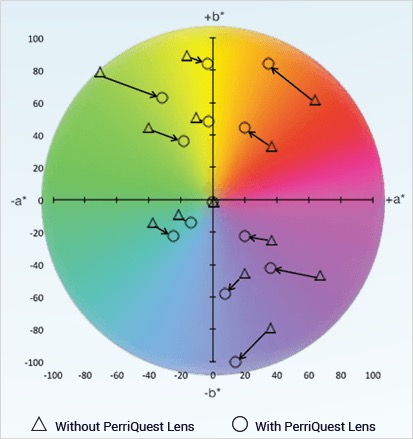
This chart from PerriQuest shows how colors shift when seen through the lens. For example, the bright green at a*=-70, b*=+80 shifts to a more yellow green; reds shift to orange. But because the shifted colors remain visible and stay within the same general hue, the manufacturer says this “eliminates the possibility of color confusion.”
LazrBloc from Revision Military
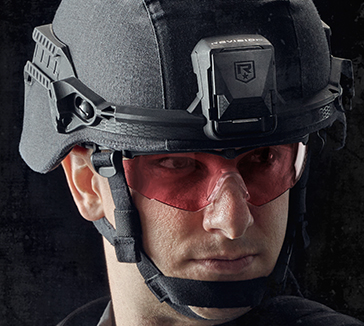
Revision’s latest laser lens—the LazrBloc GF-8—is a cross-functional aviation, law enforcement, and military solution for in-field vision disruption, disorientation, and impairment caused by green laser energy. GF-8 lenses block up to 99.9% of 532 nm green laser energy, and stop 99% of 808 nm near-infrared radiation, a hazardous, invisible component of green lasers. GF-8 laser lenses allow greater VLT and color recognition, are treated with Revision’s OcuMax© Plus anti-fog coating, provide 100% UV-A-B-C protection, and are made from high-impact polycarbonate that exceeds military ballistic impact requirements. GF-8 comes in various kits, and is priced at $199.99.
Revision’s LazrBloc lenses are interchangeable, situation–adaptable LEP solutions that can be tailored and customized to end-user needs and requirements. Revision provides ballistic LEP, in a variety of configurations and form factors, to military forces worldwide.
NOTE FOR POLICE/PROTEST USE: A July 10 2020 sole-source contract saw the Federal Protection Service buying Stingerhawk FT-2 Laser Protective Eyewear from Revision Military. The expected cost was $125 per pair, for 1,000 pairs of glasses. The contract went on to justify the sole-source: "While several manufacturers make lenses that defeat the effects of these lasers specifically designed for Law Enforcement and aviators; the Revision FT-2 Laser Protective Eyewear model provides a broader laser protection to include protection from Green, Blue and Violet laser light. The FT-2 has adequate visible light transmission and FPS has also had reports of violet laser use during these demonstrations creating the need for the broader protection. Revision Hawk was the provider of the rest of FPS head gear; therefore, the Revision Hawk Stingerhawk FT-2 Eyewear is made to to works with the helmets that FPS utilizes. The Stingerhawk FT-2 Laser Protective Eyewear provide the needed protection for the laser wavelength of concern, the feature wrap around protection and ballistic protection required for law enforcement operations. Market Research shows that there are no distributors of the lens; they are only available from the manufacturer."
ST Laserstrike from ST Laserstrike (Brinell Vision, Optimum RX Lens and Sierra Tango)
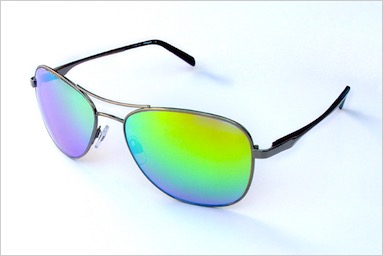
There are two different frames, including one that resembles typical aviator sunglasses.
ST Laserstrike has two levels of protection available:
Type 1 – General laser flash protection (suitable for most operations)
Allow normal operation with laser pointers <200mW* Provide eye damage protection from sources up to 2W, based on pilot being >200m from source & typical beam divergence. To comply with minimum EN207 DIR LB2 (400-445nm blue, 532nm green, 808-1064nm Infrared). Provide approx. 40% Visible Light Transmission
Type 2 – High powered laser attack protection (suitable for extreme environments)
Allow normal operation with laser pointers <2W, and eye damage protection from sources up to 20W, based on pilot being >200m from source & typical beam divergence. To comply with minimum EN207 DIR LB3 (400-445nm blue, 532nm green, 808-1064nm Infrared). Provide approx. 30% Visible Light Transmission
Laser Strike Eyewear from Phillips Safety Products
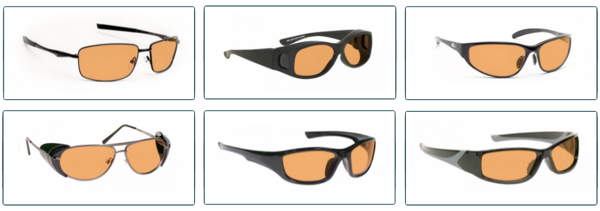
These are the six different frame styles
For each frame style, there are three different lens types available:
- Green Beam Reduction: 190-400 nm (UV), OD 5+. 532 nm (green), OD 2.5+. Visible light transmission: 33%. Orange/Peach lens color.
- Blue/Green Beam Reduction: 190-400 nm (UV), OD 5+. 445-450 nm (blue), OD 2+. 532 nm (green), OD 2.5+. Visible light transmission: 43%. Orange/Peach lens color.
- Blue/Green/Red Beam Reduction: 190-400 nm (UV), OD 5+. 440-470 nm (blue), OD 1.5+. 532 nm (green), OD 1.5+. 633-640 nm (red), OD 1.2+. Visible light transmission: 23.3%. Green lens color.
The cost is $150 in single quantities.
Laser Dazzle Visor from Folium Optics (liquid crystal shutter under development)
It can be integrated into visors, goggles or other eyewear. Below is an “early prototype” showing detectors above the nose bridge and batteries on one earpiece:
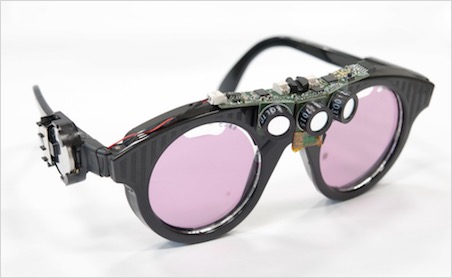
They began work on the “laser dazzle visor” in 2014 and hope to start selling to military, airline suppliers and emergency services in 2018. A March 2017 article in the Express gives some additional information.

